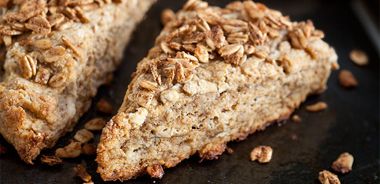Banana Buzz Scones

These scones are sure to start your morning off right. Delicious while still warm with a thin spread of almond butter.
1/3 cup (80 mL) rolled oats
1/2 tsp (2 mL) ground cinnamon
1/2 tsp (2 mL) ground ginger
2 tsp (10 mL) maple syrup
2 cups (500 mL) whole wheat pastry flour
4 tsp (20 mL) baking powder
1/2 tsp (2 mL) salt
2 Tbsp (30 mL) coconut sugar or sucanat
1/3 cup (80 mL) cold coconut oil
1/2 cup (125 mL) mashed ripe banana (about 2 bananas)
1/4 cup + 2 Tbsp (90 mL) skim milk or almond milk, divided
1/4 cup (60 mL) strong brewed coffee
1 tsp (5 mL) vanilla extract
Preheat oven to 425 F (220 C). Line baking sheet with parchment paper.
In small bowl, stir together oats, cinnamon, ginger, and maple syrup until well combined. Set aside.
In large bowl, whisk together flour, baking powder, salt, and sugar. Using pastry blender or two dinner knives, cut cold coconut oil into flour mixture until it resembles coarse crumbs.
Whisk together banana, 1/4 cup (60 mL) milk, coffee, and vanilla in small bowl. Pour over flour mixture and, with fork, gently toss together until rough dough forms. Don’t over mix dough or scones will end up being tough and dense. Form into a ball and transfer dough onto lightly floured work surface.
Flatten ball into a round disc about 1 in (2.5 cm) thick. Using sharp knife, cut dough into 10 wedges. Transfer wedges onto prepared baking sheet and lightly brush tops with remaining 2 Tbsp (30 mL) milk.
Sprinkle with oat mixture and bake until lightly browned, about 15 to 18 minutes. Transfer to wire rack to cool slightly before serving.
Makes 10 scones.
Each scone contains: 164 calories; 3 g protein; 8 g total fat (6 g sat. fat, 0 g trans fat); 25 g total carbohydrates (6 g sugars, 2 g fibre); 129 mg sodium
source: "Cooking with Coffee", alive #373, November 2013





